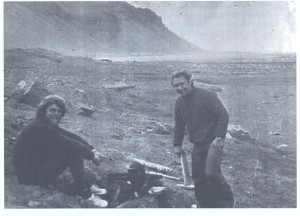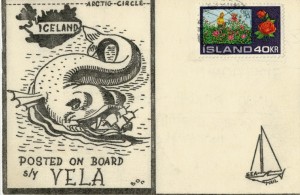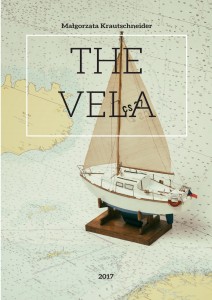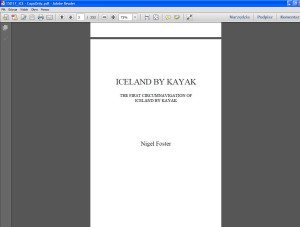Było lato 1977 roku; chłodne lato, w dalekiej, owianej arktycznym powietrzem Islandii. Przy kei w Seydisfjordur, w przemysłowym krajobrazie magazynów handlowych stał mały, jakby opuszczony, skromnie wyglądający jacht z powiewającą na rufie, nigdy nie widzianą tu banderą.
Mała Vela pod czechosłowacką banderą, bo ona była tym jachtem, zwróciła uwagę dwóch młodych, dwudziestoparoletnich Anglików, którzy właśnie w Seydisfjordur kończyli niebywałe przedsięwzięcie, wymagające trudu i odwagi – podobnie jak islandzki rejs od także młodej jak Anglicy załogi Veli – pierwsze opłynięcie Islandii kajakiem.
Spotkanie żeglarzy i kajakarzy do jakiego wówczas doszło i krótkie, wspólne chwile w zimnej, dalekiej Islandii odżyły po czterdziestu latach we wspomnieniach uczestników tamtych wypraw.
Polka, Małgorzata Krautschneider, uczestniczka rejsu Velą, tak oto opisuje w wydanej w 2017 roku swojej książce The Vela tamto spotkanie:
(…) But one day we had an occasion to swap that for English pud ding! Ruda met two Englishmen who had circumnavigated Iceland in kayaks. In their kayaks, Nigel Foster and Geoff Hunter had paddled for almost ten weeks and completed 1500 miles. It had never been attempted before. Full of admiration for their feat, Ruda invited them for dinner. I was looking forward to trying the traditional English food which I only knew about from literature.
ding! Ruda met two Englishmen who had circumnavigated Iceland in kayaks. In their kayaks, Nigel Foster and Geoff Hunter had paddled for almost ten weeks and completed 1500 miles. It had never been attempted before. Full of admiration for their feat, Ruda invited them for dinner. I was looking forward to trying the traditional English food which I only knew about from literature.
Nigel Foster and Geoff Hunter in Iceland
Our chef’s “putty” was ready and Ruda found an old stock Czech liqueur, Becherovka. I liked these men. Blond, blue-eyed, Nigel was my age and Geoff was more mature, with a nice smile. They were very friendly companions. We talked about ours adventures long into night meanwhile praising each other’s dishes. The English pudding was awful but I pretended that I liked it. Our guests looked at me with undisguised admiration. My femininity was flattered, I felt like a queen. (…)
Pomimo upływu lat islandzkie spotkanie również żywe jest także w pamięci brytyjskich kajakarzy. Nigel Foster pisze książkę o opłynięciu kajakiem Islandii, w której tak oto wspomina wspólne chwile z załogą Veli w Seydisfjordur: (…) Across the fjord, a small sailing yacht rested forlorn against a quay by some derelict warehouses. It looked so out of place we walked around the end of the fjord, and through the town to investigate and found the Czech man Ruda (Rudolf), skipper of the boat, with an attractive Polish girl, Malgorzata and Pavel, another Czech man. They had installed themselves in a deserted building, making it their makeshift home. Malgorzata had swollen feet and ankles, possibly from the inactivity and the cold aboard the 21-foot yacht, and they were concerned about her health. Ruda said they had sailed from the Baltic across to Scotland and then from Shetland and Faeroe to Iceland. All this was in that tiny sail boat. I was impressed.
I liked them. They seemed kindred spirits, willing to get out and explore using what they had available. Ruda talked about playwrights, who had to be careful not to be too political with plays or the would get into trouble with the authorities. Czechoslovakia was not the place to speak without caution.
For this trip Ruda had printed “postcards” he would roll into an empty bottle, stopper up and drop into the water, each a “message in a bottle.” Who knows where they might drift and who might find them. Each postcard showed a map outline of Iceland with the sea to the south dominated by a huge sea monster, a whale, swallowing a sailing ship. Also printed on it were the words “Posted on Board s/y Vela.” Vela (whale) was the name of his yacht. At the other corner of the card was a stylized image of a yacht with the words “SEA MAIL”. Ruda took an uncut sheet of two printed cards, stamped it with his two different rubber VELA yacht stamps, and then all three of them signed. “And year next?” He asked along the bottom.
and drop into the water, each a “message in a bottle.” Who knows where they might drift and who might find them. Each postcard showed a map outline of Iceland with the sea to the south dominated by a huge sea monster, a whale, swallowing a sailing ship. Also printed on it were the words “Posted on Board s/y Vela.” Vela (whale) was the name of his yacht. At the other corner of the card was a stylized image of a yacht with the words “SEA MAIL”. Ruda took an uncut sheet of two printed cards, stamped it with his two different rubber VELA yacht stamps, and then all three of them signed. “And year next?” He asked along the bottom.
“Yes,” I asked when he had finished and handed it to me, “So what about next year? Do you have plans?” Ruda had dreams. He planned to build a sailboat with a steel hull to explore the arctic, maybe Spitsbergen. After the Arctic, maybe he would go to Antarctica. “Perhaps you would like to come?” He asked. (…)
Upływające lata wypełnione były kontynuowaniem i rozwijaniem, i to z dużymi sukcesami, pasji: kajakowych w przypadku Fostera i Huntera oraz żeglarskich w przypadku Rudy i Małgosi Krautschneiderów, których islandzki rejs na długi czas połączył więzami małżeńskimi.
Po latach życiowe drogi zawiodły Autorkę książki The Vela do Ameryki, do Nowego Jorku i tam przez przypadek nawiązała kontakt z Nigelem Fosterem, który jak się okazało również zamieszkał w USA, tyle że, po drugiej stronie kontynentu, na zachodnim wybrzeżu.
Więcej o Nigelu Fosterze i jego kajakowych dokonaniach na: https://en.wikipedia.org/wiki/Nigel_Foster_(kayaker)
(zs)


